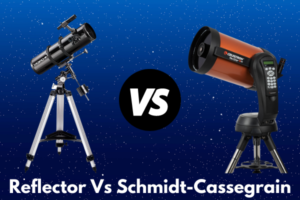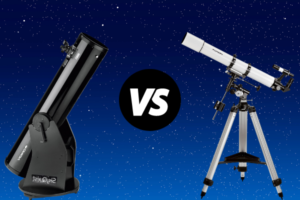Why Does A Telescope Need To Cool Down; Thermal Equilibrium Optimization
Disclosure: This post contains affiliate links and I may earn a small commission (at no extra cost to you) if you click through and make a purchase. Thanks in advance – I really appreciate it!
When I initially came to know that even ‘Thermal Dynamics’ can be a deciding factor in the quality of image my telescope produces, my first reaction was – “here’s another thing that I need to worry about”. So I did my own research and found out that before I can use my telescope for stargazing I first need to allow every part of my telescope to cool down to an ambient temperature.
Key Takeaways:
Why does a telescope need to cool down?
A telescope needs to cool down because “tube currents” are formed inside the body of the telescope when warm air rises from the hotter parts of the instrument. Since warm air has a different refractive power than cooler air, it compromises the telescope’s ability to produce a sharp image.
To create the ideal conditions to see more clearly through your telescope that you just brought out of storage, you need to thermally optimize your telescope. In this article, I will explain in detail why you need to do that and how you can always keep your scope at the right temperature to minimize the cool-down time.
Why Does A Telescope Need To Cool Down
When you take your telescope outside, there is a slew of factors that come into play. Thermodynamics, atmospheric conditions, light pollution, and cloud cover are only a few of the forces at play. While you may not have perfect control over all of these factors, you can at the least make sure that your telescope is at the optimum temperature before you can use it to observe celestial objects.
For a perfect night of stargazing, it is imperative that your telescope is at an ideal thermal condition that allows for the sharpest image reproduction while reducing dew and convection current effects.
Both dew and warm convection currents have the potential to ruin your night of observation. When the temperature of your telescope tube and the ambient air differs, both factors come into play.
What are tube currents in a telescope?
Tube currents or convection currents are formed inside the telescope tube when the warm air from your warm telescope tube starts mixing with the cooler atmospheric air surrounding it.
On the outside of your telescope, the heat can easily dissipate into the air around it. However, on the inside of the tube, the warm air is trapped in the form of tube currents.
Related:
- Best Telescope For Smartphone Astrophotography; Reviews
- Best Refractor Telescope For Beginners; Reviews
How do tube currents affect the image produced by a telescope?
As I mentioned before, when you bring your telescope out from the storage, it’s generally warmer than the outside air. This difference in temperature causes the formation of tube currents that gets trapped inside your telescope.
If you point your telescope towards a sky object in this condition, the light that’s coming from that object will have to first pass through the cooler atmospheric air in the front of the telescope, and then through the warmer air that’s trapped inside the tube.
Two laws of thermodynamics come into play here:
- Cold air is denser than warmer air.
- Warmer air has a different refractive power than cooler air.
So when light passes through the denser (cool) air to the thinner (warmer) air, each environment affects the light differently. This interferes with your telescope’s ability to bring light into sharp focus, and the result you’ll see is a distorted “dancing” and blurred image.
The longer the optical path inside your telescope and the more difference there is between the air temperatures, the greater the problems the tube currents can cause.
Since larger telescopes have a longer optical path and a larger surface area to cool down, they are more affected by the change in temperatures than their smaller counterparts.
Reflectors also tend to suffer more than refractors because in a reflector telescope tube light has to bend and be reflected towards the eyepiece away from the tube walls, that is where tube currents are at their worst.
How does dew affect the image produced by a telescope?
Dew formation or condensation is another factor that we need to consider when it comes to your telescope being at an optimum thermal condition.
Dew forms as a result of the outside air cooling off and forcing water vapor to condense and collect on every exposed surface of your telescope.
If you have just brought out your telescope from the warmth of your home into the cold outside air, then the telescope is at a greater risk of being affected by dew formation on its uncovered surfaces which would ultimately affect the quality of the image it produces.
Both dew and tube currents change the way the light behaves, thus changing the image you get.
What is the best way to cool down a telescope?
Allowing your telescope to thermally optimize or gradually cool down on its own is the way to go. If you take your telescope outside and begin using it straight away, your seeing will gradually degrade with each passing minute as your telescope cools and warm tube currents start forming inside your instrument.
This might discourage you to the extent that you may even pack up your telescope and call it a day.
I highly recommend that you should keep your telescope outside for at least 30 minutes to allow each piece of equipment to cool down individually.
A small or medium telescope might cool down fully in 30 minutes, but a large one can take a few hours to acclimatize.
As I mentioned before, larger telescopes mean they have large parts and larger surface area, so they are bound to take longer to cool down as compared to a small or a medium telescope. Fans blowing gently inside the tube on the back of the mirror can greatly help you cool down the telescope faster than when left to do it on its own.
Tips To Cool Down A Telescope
The simplest way to eliminate tube currents is to just allow every part of your telescope to cool to the ambient temperature on its own. There are some methods we can apply to speed up the whole process of telescope cool down.
- Make sure that you don’t store your telescope in the warmest room of your home, or near a heater or a vent. Don’t cover your telescope with a blanket or any heat-trapping material. The best place to store your telescope is your shed or garage.
- You can speed up the cooling of a Newtonian telescope by fitting an electric fan to the rear cell so that it blows onto the rear face of the mirror. The fan will help in quickly bringing the internal pieces of your telescope down to ambient temperature. Also, a combination of rear and side fans can be used both for effective cool-down and for controlling the hot turbulent boundary layer off the surface of the mirror.
- You may even place a free-standing fan next to your telescope to blow air and cool down the mirror end. This low-tech method can expedite the cooling down of your telescope so that you can start your stargazing session sooner.
- Give your telescope plenty of time to acclimatize to the outside temperature before you use it. A small telescope will need at least 30 minutes and a larger telescope might take a few hours to cool down to an ambient temperature.
How to prevent dew formation on your telescope?
The best way to prevent dew formation on your telescope is to use a dew shield or a dew heater. A dew shield extends the tube and provides additional protection by keeping the air in front of the optics at a stable temperature. A dew heater simply keeps your telescope at a stable temperature.
Written by:

Kavya Joshi
My love affair with space began in a field in India at the age of 7, when I looked up at the Milky Way for the first time. Ever since, I have been attempting to cram in every fact about the Universe, I can find into my head.
ABOUT US
We are a team of active amateur astronomers, here to help you with all your astronomy and science related needs – this is anything, from reviewing the latest telescopes to be released to talking about gravity and neurons. The Big Bang Optics was started because of our love for astronomy and to help others like us find the best telescope and accessories.
LEGAL DISCLAIMER
The Big Bang Optics is a participant in the Amazon Services LLC Associates Program, an affiliate advertising program designed to provide a means for sites to earn advertising fees by advertising and linking to Amazon.com. The Big Bang Optics also participates in affiliate programs with Clickbank and other sites. The Big Bang Optics is compensated for referring traffic and business to these companies.




